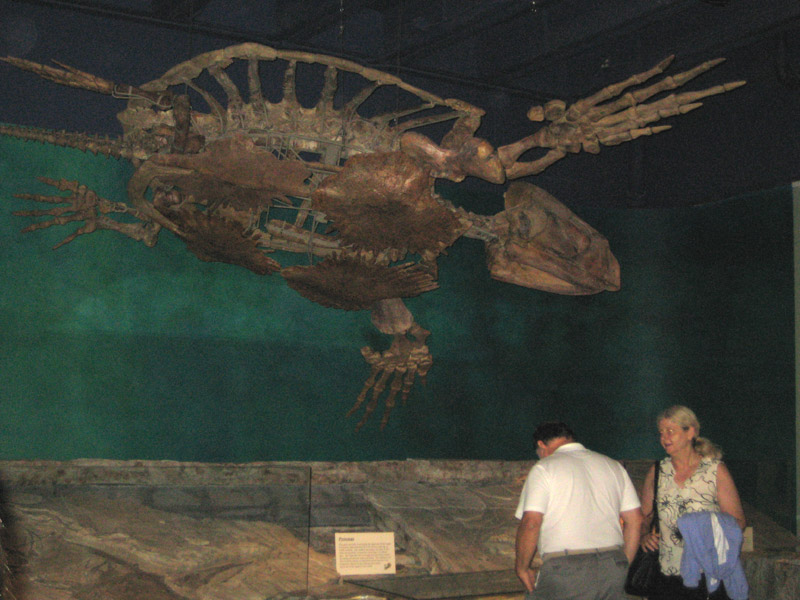For example:
Did you know that this part of Texas was once part of the sea and that Mosasaurs and Giant Sea Turtles (Protostega) swam here? During much of the Cretaceous geologic period, from 146 million years ago to 65 million years ago, a shallow sea split the North American continent.....going right through what is now Texas. Huge reptiles, like the Mosasaur and Protostega, lived in that sea and dinosaurs walked next to it. Their fossils, that have been preserved for millions of years, now provide a background of our past and a source of unending educational research opportunities to understand that time in our Earth's history. It's a fact, as you can see from these photos from the Dallas Museum of Natural History, now the Perot Museum of Nature and Science.


Mosasaur Protostega http://www.northtexasfossils.com/
The Mosasaur was discovered in Rockwall County, and the Protostega was found when a farmer not far from Dallas,drove his tractor over it, then realized he had struck something rather large. Viola...Protostega was found. If you look in the creek bottoms around here you are bound to find fossils of oysters and other bivalves in the limestone. My brother and I found them all of the time as kids when we explored creeks near White Rock Lake. No living oysters around here anymore........
This past week I had the pleasure of attending a presentation by two SMU students who were giving a synopsis of their projects in the Great Trinity Forest. Both did exemplary research, one on the succession of trees in the forest, and the other a study of the mammals living in the forest. The site for the studies was the Trinity River Audubon Center (TRAC) which is located on the old Deep Woods landfill, a notorious toxic dumping site. Both studies are of vital interest due to the fact that some of the area was untouched by the now cleaned up landfill providing a good comparison to the reconstituted land around the center itself.
Both presentations ended with declarations of the fact that the GTF is an undeniably important location for continued scientific study and that great care should be taken to protect this valuable asset for our City. Sound familiar? Afterwards we were invited to a private tour of the Shuler Museum where we were taken by Dr. Louis Jacobs, President of Southern Methodist University's Institute for the Study of Earth and Man, to see some new discoveries, but especially to see the old fossils found in the gravel pits from the early 1900's that were located along the Trinity from Big Spring to TRAC, where the Horse Park and Golf Course are being built by the city.
Why would this be important? Because knowledge of the past is a part of the education process so that we can use best judgement on land use and future development. The sight of fossils from near the very site of the Horse Park was amazing. The old gravel pits had been a wealth of information pertaining to the period of the Pleistocene when saber toothed cats, camels, horses, mammoths, and more roamed this part of the world.
Imagine seeing the lower jaw from a new species of saber toothed cat that was unearthed in what is now referred to as the Pemberton pit. As the http://dallastrinitytrails.blogspot.com/2014/02/big-spring-in-snow-dallas-great-trinity.html has stated before, this was a spectacular discovery. Simply amazing and makes me wonder why on earth the consideration of scientific discovery was not pursued and developed upon by the City. Imagine the benefits to the education of school children, continued research by college students and dedicated scientists when these discoveries from the past could have led to a museum/interpretive center that included an active paleontology/archeology dig site?
Sustainable development goes hand-in-hand with educational opportunity.
 | |||||||||||||||
| Dr. Louis Jacobs holding the Pemberton Pit saber toothed cat lower jaw | dallastrinitytrails.blogspot.com |
No comments:
Post a Comment
Thank you for reading and commenting on my blog! In an effort to control internet trolls and robots, I review comments, and once I know you're a real, live person, I will approve your comment for posting!
Thanks again for your interest in my wonderful hometown, Dallas, Texas!!
Becky Rader